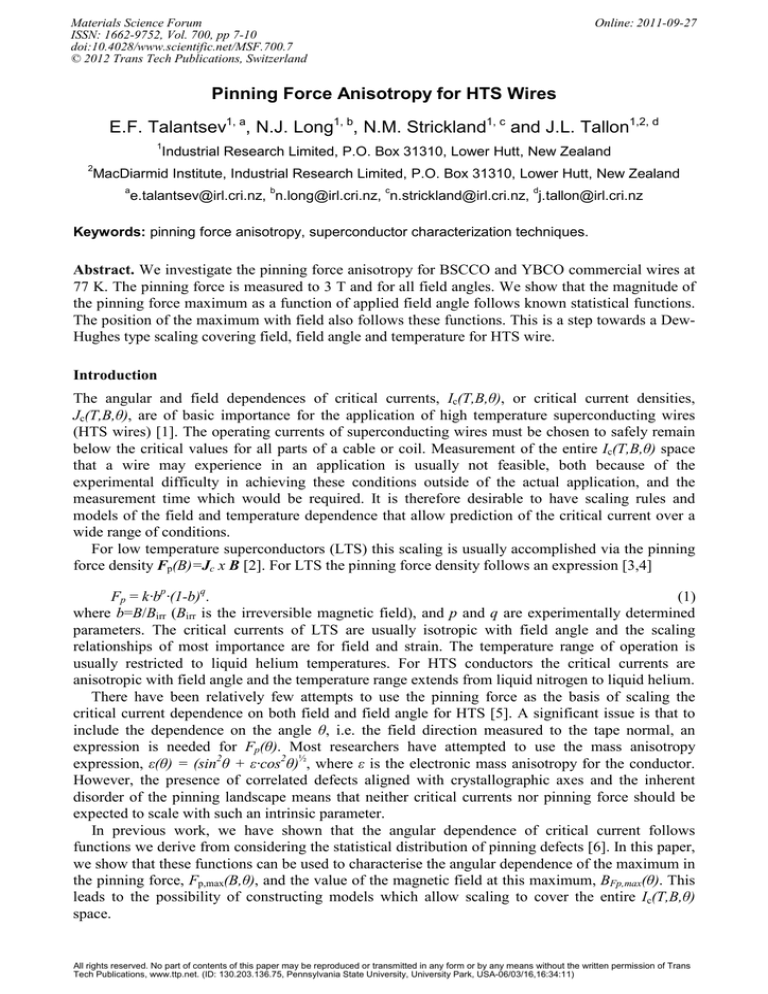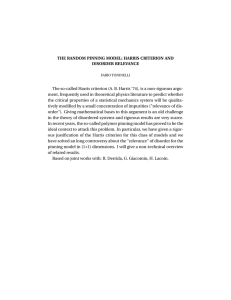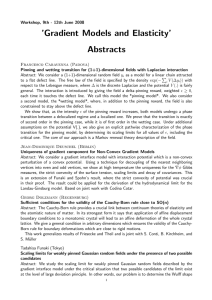
Materials Science Forum
ISSN: 1662-9752, Vol. 700, pp 7-10
doi:10.4028/www.scientific.net/MSF.700.7
© 2012 Trans Tech Publications, Switzerland
Online: 2011-09-27
Pinning Force Anisotropy for HTS Wires
E.F. Talantsev1, a, N.J. Long1, b, N.M. Strickland1, c and J.L. Tallon1,2, d
1
Industrial Research Limited, P.O. Box 31310, Lower Hutt, New Zealand
2
MacDiarmid Institute, Industrial Research Limited, P.O. Box 31310, Lower Hutt, New Zealand
a
b
c
d
e.talantsev@irl.cri.nz, n.long@irl.cri.nz, n.strickland@irl.cri.nz, j.tallon@irl.cri.nz
Keywords: pinning force anisotropy, superconductor characterization techniques.
Abstract. We investigate the pinning force anisotropy for BSCCO and YBCO commercial wires at
77 K. The pinning force is measured to 3 T and for all field angles. We show that the magnitude of
the pinning force maximum as a function of applied field angle follows known statistical functions.
The position of the maximum with field also follows these functions. This is a step towards a DewHughes type scaling covering field, field angle and temperature for HTS wire.
Introduction
The angular and field dependences of critical currents, Ic(T,B,θ), or critical current densities,
Jc(T,B,θ), are of basic importance for the application of high temperature superconducting wires
(HTS wires) [1]. The operating currents of superconducting wires must be chosen to safely remain
below the critical values for all parts of a cable or coil. Measurement of the entire Ic(T,B,θ) space
that a wire may experience in an application is usually not feasible, both because of the
experimental difficulty in achieving these conditions outside of the actual application, and the
measurement time which would be required. It is therefore desirable to have scaling rules and
models of the field and temperature dependence that allow prediction of the critical current over a
wide range of conditions.
For low temperature superconductors (LTS) this scaling is usually accomplished via the pinning
force density Fp(B)=Jc x B [2]. For LTS the pinning force density follows an expression [3,4]
Fp = k·bp·(1-b)q.
(1)
where b=B/Birr (Birr is the irreversible magnetic field), and p and q are experimentally determined
parameters. The critical currents of LTS are usually isotropic with field angle and the scaling
relationships of most importance are for field and strain. The temperature range of operation is
usually restricted to liquid helium temperatures. For HTS conductors the critical currents are
anisotropic with field angle and the temperature range extends from liquid nitrogen to liquid helium.
There have been relatively few attempts to use the pinning force as the basis of scaling the
critical current dependence on both field and field angle for HTS [5]. A significant issue is that to
include the dependence on the angle θ, i.e. the field direction measured to the tape normal, an
expression is needed for Fp(θ). Most researchers have attempted to use the mass anisotropy
expression, ε(θ) = (sin2θ + ε·cos2θ)½, where ε is the electronic mass anisotropy for the conductor.
However, the presence of correlated defects aligned with crystallographic axes and the inherent
disorder of the pinning landscape means that neither critical currents nor pinning force should be
expected to scale with such an intrinsic parameter.
In previous work, we have shown that the angular dependence of critical current follows
functions we derive from considering the statistical distribution of pinning defects [6]. In this paper,
we show that these functions can be used to characterise the angular dependence of the maximum in
the pinning force, Fp,max(B,θ), and the value of the magnetic field at this maximum, BFp,max(θ). This
leads to the possibility of constructing models which allow scaling to cover the entire Ic(T,B,θ)
space.
All rights reserved. No part of contents of this paper may be reproduced or transmitted in any form or by any means without the written permission of Trans
Tech Publications, www.ttp.net. (ID: 130.203.136.75, Pennsylvania State University, University Park, USA-06/03/16,16:34:11)
8
Advanced Materials and Nanotechnology
The statistical functions are an angular Lorentzian function
J1 ⋅ Γ
Γ sin θ + cos 2 θ .
(2)
This is derived from considering the distribution of θ, where, θ = cos-1(w) and w is a Lorentzian
distributed random variable. And an angular Gaussian function
J c (θ ) =
2
2
J2
cosec 2θ ⋅ exp( − cot 2 θ / 2Γ 2 )
Γ
.
(3)
where likewise w is Gaussian distributed, (for details see Ref. 6). These can also be combined into
angular pseudo-Voigt functions by taking a linear combination of (2) and (3).
J c (θ ) =
Experimental
We have studied commercially available HTS wires and R&D samples from American
Superconductor Corporation (AMSC). In-field measurements were performed in a 3 T HTS magnet
designed and built by HTS-110 Ltd. We immersed the HTS samples in liquid nitrogen at 77 K. A
four-point technique and a 1 µV/cm voltage criterion for transport current measurements were used.
Other experimental details are described elsewhere [6].
Results and Discussions
To illustrate the general behavior of critical current density and pinning force density as functions of
B, we present typical Je(B) and Fp(B) curves for Bi-2223 (BSCCO) [7] AMSC commercial unlaminated Ag-sheathed tape (1G wire) in Fig. 1. This shows the main features of Jc(B) and Fp(B)
that are common for most HTS. Critical current density (in this case, Je(B)) decreases monotonically
with field, B. The pinning force, Fp(B), reaches its maximum, Fp,max(B), at the field labelled BFp,max,
and at this field the critical current density has the value Je Fp,max. As magnetic field, B, increases
further, Fp(B) decreases and reaches zero at Birr.
Fig. 1. Je(B) and Fp(B) for AMSC 1G wire. Data is for 77 K and θ = 0°.
Bi-2223 wire
The experimental study for 1G HTS wire was performed using commercial laminated BSCCO/Agsheathed tape. In Fig. 2(a) we plot a 3D representation of the pinning force, Fp(B,θ). The green
circles in Fig. 2(a) indicate points where the pinning force has reached its maximum value,
Fp,max(B,θ). The physical interpretation of the magnitude and position of the pinning force maximum
is open to question [3,4]. A simple model is to postulate that at the pinning force maximum, Fp,max,
the flux vortices are maximally accommodated to the available density of pinning channels in the
material. As additional vortices are added, they are pinned mainly by the interaction with other
vortices. The field at which this occurs, BFp,max(θ) is therefore a kind of matching field which gives
the effective areal density of these channels, which we label Neff.
Materials Science Forum Vol. 700
9
In Fig. 2(b) we plot Fp,max(θ), BFp,max(θ) for the data of Fig. 2(a). We also calculate the current at
the maximum IFp,max(θ)=Fp,max/BFp. Within our simple model, this value is proportional to the flux
pinning force per unit length of vortex, fp, as BFp ~ Neff·φ0 (where φ0=2·10-15 Wb) and Fp,max=Neff·fp,
giving Jc ~ fp/φ0. Interestingly we find that this value is relatively constant with a magnitude
Ic Fp,max(BFp,max, θ) = 127 ± 11 A.
(4)
The wire is approximately 4 mm x 0.2 mm with a fill factor of 40%, giving a Jc Fp,max ~ 0.04
MA/cm2. The constant magnitude implies that the average flux pinning per unit vortex line is
relatively independent of angle and is also independent of field. The variation in the critical current
with angle is therefore arising mainly due to the variation in the number of effective pinning
channels, represented by BFp,max(θ). As can be seen in Fig. 2(b) this number varies strongly by a
factor of about seven from perpendicular (θ = 0°) to parallel fields (θ = 90°).
a
b
Fig. 2. (a) Fp(B,θ) surface for AMSC 1G HTS wire at 77 K. (b) Fp,max(θ), BFp,max(θ), and Ie Fp,max(θ).
Fp, max(θ) fitted to the angular Lorentzian function (Eq. 2, A1=11.1, Γ1=0.20); BFpe, max(θ) fitted to
the angular Lorentzian function (Eq. 2, A1=0.18, Γ1=0.24).
In Fig. 2(b) we have fitted the Fp,max(θ), and BFp,max(θ) to Eq. 2. The physical interpretation of this
fitting is that correlated pinning defects which exist over a number of different length scales, and are
broadly aligned to the crystallographic axes, are responsible for the density of pinning channels
though the material. To scale the currents in the form of Eq. 1 we can use the Fp,max(θ) fitting to
scale Fp(B,θ)/Fp,max(θ). Unfortunately, we cannot yet scale the B axis as we do not know the
magnitude of Birr(θ). An investigation of this will be left for a follow-up paper.
YBCO wire
We studied commercially available laminated YBa2Cu3O7-x+50at.%Dy wire [1]. The experimental
pinning force density, Fp,max(B,θ), are shown in Fig. 3(a). The YBCO wire has much higher
irreversibility fields than BSCCO. For this tape, the Jc Fp,max(θ) is not constant (Fig. 3(b)), but its
variation from 0° to 90°, is proportionately much less than that for Fp,max(θ).
We obtain a value of Jc Fp,max ~ 0.4 MA/cm2. This is a factor of 10 higher than for the BSCCO
wire. This is not unexpected as the vortices of BSCCO have a 2D character and are known to be
weakly coupled across the cuprate layers making them much harder to pin effectively.
In Fig. 3(b) the Fp,max(θ), and BFp,max(θ) are fitted to a combination of Eq. 2 + Eq. 3. We refer to
this as a pseudo-Voigt fitting. The physical interpretation is that the Gaussian contribution is arising
from one particularly strong population of defects. The shoulders in BFp,max(θ), are also sometimes
seen in Jc(θ) data and are an unusual effect of transposing a broad Gaussian distribution into the
angular domain [6]. Again it will be possible to use the fitting of Fp,max(θ), to scale the Fp data. To
scale B we again need to know the magnitude of Birr(θ). With this data, it may be possible to
produce a universal scaling of the form of Eq. 1.
10
Advanced Materials and Nanotechnology
a
b
Fig. 3. (a) The Fp(B,θ) surface for AMSC 2G HTS wire at 77 K. (b) Fp,max(θ), BFp,max(θ), and
Jc Fp,max(θ). Fp,max(θ) fitted to an angular pseudo-Voigt function (Eq. 2 + Eq. 3) with Lorentzian part
(Eq. 2, A1=0.42, Γ1=0.05), and Gaussian part (Eq. 3, A2=0.42, Γ2=0.26). BFp,max(θ) fitted to an
angular pseudo-Voigt function (Eq. 2+Eq. 3) with Lorentzian part (Eq. 2, A1=0.16, Γ1=0.05) and
Gaussian part (Eq. 3, A2=0.4, Γ2=1.1).
Summary
We have investigated the pinning force anisotropy as a function of field and angle for BSCCO and
YBCO wire. We show that the magnitude and position of the pinning force maximum as a function
of angle fits simple statistical functions. Combined with further data on Birr(θ) this may allow field
and field angle scaling of the Fp, max(θ) data of the Dew-Hughes form. Scaling with temperature also
remains to be investigated.
Reference
[1] S. Fleshler, D. Buczek, B. Carter, P. Cedrone, K. DeMoranville, et al, Scale-up of 2G wire
manufacturing at American Superconductor Corporation, Physica C 469 (2009) 1316-1321
[2] J.W. Ekin, Unified scaling law for flux pinning in practical superconductors: I. Separability
postulate, raw scaling data and parameterization at moderate strains, Supercond. Sci. Technol. 23
(2010) 083001
[3] E.J. Kramer, Scaling laws for flux pinning in hard superconductors, J. Appl. Phys. 44 (1973)
1360-1370
[4] D. Dew-Hughes, Flux pinning mechanisms in type II superconductors, Phil. Mag. 30 (1974)
293-305
[5] X.J. Xu, J. Fang, X.W. Cao and K. Li, A scaling formula of critical current density for
anisotropic superconductors, J. Phys. D: Appl. Phys. 29 (1996) 2473–2475
[6] N.J. Long, Model for the angular dependence of critical currents in technical superconductors,
Supercond. Sci. Technol. 21 (2008) 025007
[7] J.L. Tallon, R.G. Buckley, P.W. Gilberd, M.R. Presland, I.W.M. Brown, M.E. Bowden, L.A.
Christian and R. Goguel, High-Tc superconducting phases in the series Bi2.1(Ca, Sr)n+lCunO2n+4+δ,
Nature 333 (1988) 153-156.
Advanced Materials and Nanotechnology
10.4028/www.scientific.net/MSF.700
Pinning Force Anisotropy for HTS Wires
10.4028/www.scientific.net/MSF.700.7
DOI References
[1] S. Fleshler, D. Buczek, B. Carter, P. Cedrone, K. DeMoranville, et al, Scale-up of 2G wire manufacturing
at American Superconductor Corporation, Physica C 469 (2009) 1316-1321.
10.1016/j.physc.2009.05.234
[2] J.W. Ekin, Unified scaling law for flux pinning in practical superconductors: I. Separability postulate, raw
scaling data and parameterization at moderate strains, Supercond. Sci. Technol. 23 (2010) 083001.
10.1088/0953-2048/23/8/083001
[3] E.J. Kramer, Scaling laws for flux pinning in hard superconductors, J. Appl. Phys. 44 (1973) 1360-1370.
10.1063/1.1662353
[4] D. Dew-Hughes, Flux pinning mechanisms in type II superconductors, Phil. Mag. 30 (1974) 293-305.
10.1080/14786439808206556
[5] X.J. Xu, J. Fang, X.W. Cao and K. Li, A scaling formula of critical current density for anisotropic
superconductors, J. Phys. D: Appl. Phys. 29 (1996) 2473–2475.
10.1088/0022-3727/29/9/036
[6] N.J. Long, Model for the angular dependence of critical currents in technical superconductors, Supercond.
Sci. Technol. 21 (2008) 025007.
10.1088/0953-2048/21/02/025007
[7] J.L. Tallon, R.G. Buckley, P.W. Gilberd, M.R. Presland, I.W.M. Brown, M.E. Bowden, L.A. Christian
and R. Goguel, High-Tc superconducting phases in the series Bi2. 1(Ca, Sr)n+lCunO2n+4+δ, Nature 333
(1988) 153-156.
10.1038/333153a0



